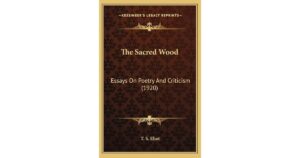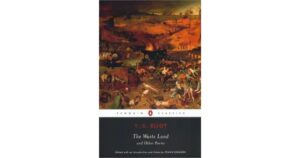T. S. Eliot and His Important Works
T. S. Eliot (1888-1965) was a renowned poet, playwright, and literary critic who made significant contributions to literary criticism. His critical essays and reviews helped shape modern literary theory and criticism.
Table of Contents

Here are some key aspects of his contribution:
- The Sacred Wood (1920): Eliot’s first collection of essays, which laid the groundwork for his critical approach, emphasizing the importance of tradition, discipline, and craftsmanship in literature.
- Tradition and the Individual Talent (1919): A seminal essay where Eliot argued that writers must engage with the literary tradition while also bringing their unique perspective to create meaningful work.
- The Function of Criticism (1923): Eliot emphasized the role of criticism in understanding literature, advocating for a balanced approach that considers both the work’s historical context and its aesthetic value.
- Objective Correlative: Eliot introduced this concept, which posits that a poem’s emotional impact is rooted in the precise arrangement of objective elements, such as images, symbols, and allusions.
- Poetic Drama: Eliot championed poetic drama, advocating for a return to verse drama and emphasizing the importance of language, imagery, and symbolism in dramatic works.
- Influence on New Criticism: Eliot’s ideas influenced the New Critics, a group of mid-20th-century critics who focused on close reading and the analysis of literary texts as autonomous objects.
- Editorship of The Criterion: Eliot edited this influential literary magazine (1922-1939), which published works by prominent modernist writers and shaped the literary landscape of the time.
T. S. Eliot’s contributions to literary criticism have had a lasting impact, shaping the way we think about literature, tradition, and the role of criticism in understanding literary works.
T. S. Eliot’s views on poetry and criticism:
Poetry:
- Objective Correlative: Eliot believed that poetry should evoke emotions through objective, precise, and arranged images, rather than direct emotional expression.
- Tradition and Innovation: He emphasized the importance of engaging with literary tradition while innovating and pushing boundaries.
- Symbolism and Allusion: Eliot saw symbolism and allusion as essential tools for conveying complex ideas and emotions in poetry.
- Poetry as a Universal Language: He believed that poetry could transcend individual experiences and speak to universal human concerns.
Criticism:
- Impersonal Criticism: Eliot advocated for an impersonal, objective approach to criticism, focusing on the text rather than personal opinions.
- The Function of Criticism: He saw criticism as a means to understand and evaluate literature, rather than simply expressing personal taste.
- Close Reading: Eliot emphasized the importance of close reading and detailed analysis in understanding literary texts.
- Criticism as a Creative Process: He believed that criticism could be a creative process, requiring the critic to engage deeply with the text and its cultural context.
Key essays that outline his views:
- “Tradition and the Individual Talent” (1919)
- “The Function of Criticism” (1923)
- “The Sacred Wood” (1920)
- “The Use of Poetry and the Use of Criticism” (1933)
Eliot’s views on poetry and criticism continue to influence literary theory and practice, emphasizing the importance of tradition, innovation, and close reading.

T. S. Eliot’s Hamlet and His Problems
T. S. Eliot’s essay “Hamlet and His Problems” (1919) argues that Hamlet is an artistic failure due to:
- Lack of objective correlative: Eliot claims that Shakespeare failed to find an objective correlative, a concrete image or situation, to express Hamlet’s emotions and thoughts.
- Inadequate dramatic structure: Eliot sees Hamlet’s dramatic structure as flawed, with too much repetition and a lack of clear progression.
- Hamlet’s character: Eliot argues that Hamlet’s character is inconsistent and lacks clear motivation, making him difficult to relate to.
- Overemphasis on intellect: Eliot believes that Shakespeare overemphasized Hamlet’s intellectual struggles, making the play too cerebral and less emotional.
- Failure to achieve tragic catharsis: Eliot thinks that Hamlet fails to achieve the tragic catharsis, or emotional purging, that a successful tragedy should provide.
Eliot’s critique is not meant to dismiss Hamlet’s artistic value but to highlight the challenges of creating a cohesive and effective tragic play. His essay remains a significant contribution to Shakespearean criticism and continues to spark debate among scholars and literary critics.
T. S. Eliot’s views on Macbeth:
- Admiration for its darkness and intensity: Eliot praised Macbeth for its exploration of the human psyche’s darker aspects, calling it “a masterpiece of gloom”.
- Appreciation for its poetic language: Eliot admired the play’s poetic and imaginative language, particularly in the witches’ prophecies and Macbeth’s soliloquies.
- Critique of its dramatic structure: Eliot argued that Macbeth’s dramatic structure is flawed, with too much repetition and a lack of clear progression.
- Interest in Macbeth’s psychological complexity: Eliot saw Macbeth as a fascinating study of a mind torn apart by guilt, ambition, and paranoia.
- Comparison to Greek tragedy: Eliot compared Macbeth to Greek tragedy, noting its exploration of fate, hubris, and the human condition.
In his essay “Shakespeare and the Stoicism of Seneca” (1927), Eliot wrote:
“Macbeth is a play about the destruction of a man by his own desires, and the destruction of a society by the corruption of its leaders.”
Overall, Eliot viewed Macbeth as a masterpiece of dark, poetic, and psychologically complex drama, but with some flaws in its dramatic structure.
T. S. Eliot’s The Metaphysical Poets
T. S. Eliot uses the term “metaphysical poets” to describe a group of 17th-century English poets who wrote in a unique style characterized by:
- Complex metaphors: They used intricate and surprising metaphors to explore philosophical and spiritual ideas.
- Intellectual curiosity: They were fascinated by the workings of the human mind, emotions, and relationships.
- Experimental language: They employed innovative language, imagery, and syntax to convey their thoughts and feelings.
Some notable metaphysical poets include:
- John Donne: Known for his complex metaphors and exploration of love, death, and spirituality.
- George Herbert: Explored themes of faith, doubt, and spiritual struggle through innovative language.
- Andrew Marvell: Wrote poems that blended politics, philosophy, and personal relationships.
- Thomas Traherne: Focused on the spiritual and emotional experiences of the individual.

Eliot admired these poets for their:
- Intellectual depth: Their poetry engaged with complex ideas and philosophical concepts.
- Innovative language: They pushed the boundaries of language and form.
- Emotional honesty: They explored personal emotions and experiences with candor.
By invoking the metaphysical poets, Eliot aimed to:
- Revitalize modern poetry: By embracing their intellectual curiosity and innovative language.
- Challenge Romanticism: By emphasizing the importance of intellect and complexity in poetry.
- Create a new poetic tradition: One that blended intellectual depth, emotional honesty, and innovative language.
T. S. Eliot rejected Tennyson and Browning for several reasons:
Tennyson:
- Lack of intellectual depth: Eliot saw Tennyson’s poetry as superficial, lacking in intellectual rigor and philosophical insight.
- Overemphasis on emotion: Tennyson’s focus on emotion and sentimentality struck Eliot as excessive and unbalanced.
- Artificial language: Eliot criticized Tennyson’s language as overly ornate and artificial, prioritizing sound over sense.
Browning:
- Obscurity and difficulty: Eliot found Browning’s poetry often obscure and difficult, prioritizing complexity over clarity.
- Lack of coherence: Eliot saw Browning’s poetry as fragmented and lacking in coherence, with ideas and images disconnected.
- Overemphasis on individualism: Browning’s focus on individual personalities and experiences struck Eliot as narrow and limited.
Eliot preferred poets who:
- Engaged with intellectual and philosophical ideas
- Used language that was precise, concise, and evocative
- Explored universal human experiences and emotions
In contrast, Tennyson and Browning represented a Victorian poetic tradition that Eliot saw as:
- Too focused on emotion and individualism
- Lacking in intellectual depth and complexity
- Overly concerned with ornamentation and style
By rejecting Tennyson and Browning, Eliot aimed to challenge prevailing poetic norms and create a new modernist poetic tradition that emphasized intellectual rigor, precision, and universality.

Important quotations about poetry from T. S. Eliot’s works:
- “Poetry is not a turning loose of emotion, but an escape from emotion; it is not the expression of personality, but an escape from personality.” – “Tradition and the Individual Talent” (1919)
- “The only way of expressing emotion in the form of art is by finding an ‘objective correlative’; in other words, a set of objects, a situation, a chain of events which shall be the formula of that particular emotion.” – “Hamlet and His Problems” (1919)
- “The poet’s mind is in fact a receptacle for seizing and storing up numberless feelings, phrases, images, which remain there until all the particles which can unite to form a new compound are present together.” – “The Use of Poetry and the Use of Criticism” (1933)
- “The business of the poet is not to find new emotions, but to use the ordinary ones and, in working them up into poetry, to express feelings which are not in actual emotions at all.” – “The Use of Poetry and the Use of Criticism” (1933)
- “Genuine poetry can communicate before it is understood.” – “The Music of Poetry” (1942)
- “The poet’s problem is not to express himself, but to express the situation.” – “The Three Voices of Poetry” (1953)
These quotations highlight Eliot’s views on poetry as an art form, the role of the poet, and the process of creating poetry.
Read and learn more: Matthew Arnold and His Touchstone Method







One thought on “T. S. Eliot and His Important Works”